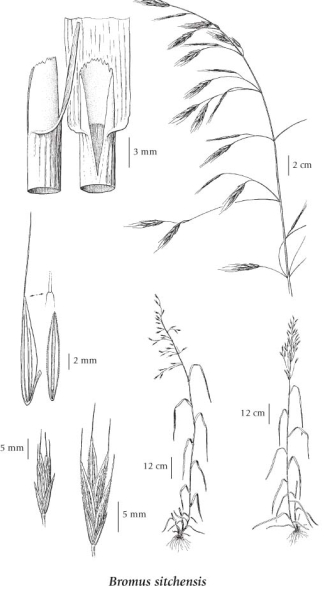Bromus sitchensis Trin.
Alaska brome
Poaceae (Grass family)
Introduction to Vascular Plants
Alaska brome
Poaceae (Grass family)
Introduction to Vascular Plants
Species Information
General:
Perennial grass from fibrous roots; stems 50-150 (200) cm tall.
Leaves:
Sheaths smooth to soft-hairy; blades (5) 8-15 mm wide, flat, smooth to soft-hairy on the dorsal surfaces at least, thin, the nerves very narrow, scarcely 1/3 as broad as the intervening areas; ear-shaped lobes lacking at the leaf-bases; ligules smooth (to crisp-hairy), jagged, pale, (2) 4-8 mm long.
Flowers:
Inflorescence a large panicle, 10-35 cm long, the branches stiffly erect to mostly spreading or drooping, usually bearing only 1 or 2 (3) spikelets near the tips; spikelets closely 4- to 8- (12-) flowered, strongly compressed, tapered from near the base, 2-4 cm long; florets mostly small, closed, self-fertilizing; glumes lanceolate, keeled, the lower ones 3- or 5-nerved, 8-10 mm long, the upper ones, 5- or 7-nerved, 2-3 mm longer; lemmas smooth to more or less short-hairy, keeled on the back, (6) 7-12 mm long, shallowly bidentate, awned, the awns straight or slightly abruptly bent, (5) 7-12 (15) mm long; rachillas completely exposed to often not exposed; paleas about equalling or exceeding the lemmas; anthers (0.5) 1-3 (6) mm long.
Notes:
The treatment here follows that of Calder and Taylor (1968) who suggested that B. aleutensis was merely a depauperate form of B. sitchensis. They can be separated only on minor and overlapping differences in panicle characteristics.
Illustration

If more than one illustration is available for a species (e.g., separate illustrations were provided for two subspecies) then links to the separate images will be provided below. Note that individual subspecies or varietal illustrations are not always available.
Illustration Source: The Illustrated Flora of British Columbia
USDA Species Characteristics
Flower Colour:
Yellow
Blooming Period:
Late Spring
Fruit/Seed characteristics:
Colour: Brown
Present from Spring to Summer
Source: The USDA
Ecology
Ecological Framework for Bromus sitchensis
The table below shows the species-specific information calculated from
original data (BEC database) provided by the BC Ministry of Forests and Range.
(Updated August, 2013)
The table below shows the species-specific information calculated from
original data (BEC database) provided by the BC Ministry of Forests and Range.
(Updated August, 2013)
| Site Information |
Value / Class |
||
|
Avg |
Min |
Max |
|
| Elevation
(metres) |
731 | 5 | 2187 |
| Slope
Gradient (%) |
15 | 0 | 82 |
|
Aspect (degrees) |
164 | 14 | 360 |
| Soil
Moisture Regime (SMR) [0 - very xeric; 4 - mesic; 8 - hydric] |
4 | 0 | 7 |
| Modal
Nutrient Regime
Class |
D | ||
| #
of field plots species was recorded in: |
91 | ||
| Modal
BEC Zone Class |
CWH | ||
|
All BEC Zones (# of stations/zone) species was recorded in |
CDF(2), CWH(40), ESSF(16), ICH(6), IDF(2), MS(3), PP(1), SBPS(2), SBS(12) | ||
|
Source:
Klinkenberg 2013
|
|||
Habitat and Range
Moist to mesic meadows, streambanks, beaches, talus slopes, avalanche tracks and open forests in the lowland, montane and subalpine zones; frequent in BC in and west of the Coast-Cascade Mountains, rare in SE BC; N to AK and S to NW OR.Status Information
Synonyms
Synonyms and Alternate Names:
Bromus aleutensis Trin. ex Griseb.
Bromus sitchensis var. aleutensis (Trin. ex Griseb.) Hultén
Bromus sitchensis var. linearis